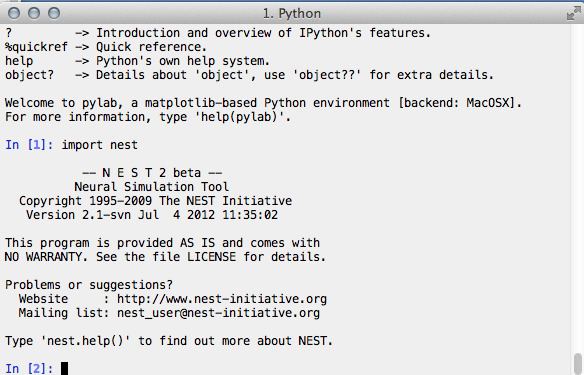Developer(s) The NEST Initiative | Development status Active | |
 | ||
Original author(s) Initial release August 1, 2004 (2004-08-01) Stable release 2.12.0 / March 1, 2017; 17 days ago (2017-03-01) | ||
NEST is a simulation software for spiking neural network models, including large-scale neuronal networks. NEST was initially developed by Markus Diesmann and Marc-Oliver Gewaltig and is now developed and maintained by the NEST Initiative.
Contents
Modeling philosophy
A NEST simulation tries to follow the logic of an electrophysiological experiment that takes place inside a computer with the difference, that the neural system to be investigated must be defined by the experimenter.
The neural system is defined by a possibly large number of neurons and their connections. In a NEST network, different neuron and synapse models can coexist. Any two neurons can have multiple connections with different properties. Thus, the connectivity can in general not be described by a weight or connectivity matrix but rather as an adjacency list.
To manipulate or observe the network dynamics, the experimenter can define so-called devices which represent the various instruments (for measuring and stimulation) found in an experiment. These devices write their data either to memory or to file.
NEST is extensible and new models for neurons, synapses, and devices can be added.
Example
The following example simulates spiking activity in a sparse random network with recurrent excitation and inhibition
The figure shows the spiking activity of 50 neurons as a raster plot. Time increases along the horizontal axis, neuron id increases along the vertical axis. Each dot corresponds to a spike of the respective neuron at a given time. The lower part of the figure shows a histogram with the mean firing-rate of the neurons.
Features
NEST is a simulator for spiking neural network models that focus on the dynamics, size, and structure of neural systems, rather than on the exact geometry of individual neurons.
Examples of such models are:
Neuron models
Network models
Synapse models
Device models
Accuracy
Parallel and distributed simulation
Interoperability
History
NEST development was started in 1993 by Markus Diesmann and Marc-Oliver Gewaltig at the Ruhr University Bochum, Bochum, Germany and the Weizmann Institute of Science in Rehovot, Israel. At this time, the simulator was called SYNOD and simulations were defined in a stack based simulation language, called SLI.
In 2001, the software changed its name from SYNOD to NEST. Until 2004, NEST was exclusively developed and used by the founding members of the NEST Initiative. The first public release appeared in summer 2004. Since then, NEST was released regularly, about once or twice per year.
Since 2007, NEST supports hybrid parallelism, using POSIX threads and MPI.
In 2008, the stack-based simulation language SLI was superseded by a modern Python interface, however, the old simulation language is still used internally. At the same time, the simulator independent specification language PyNN was developed with support for NEST. In 2012, the NEST Initiative changed the license from the proprietary NEST License to GNU GPL V2 or later.
